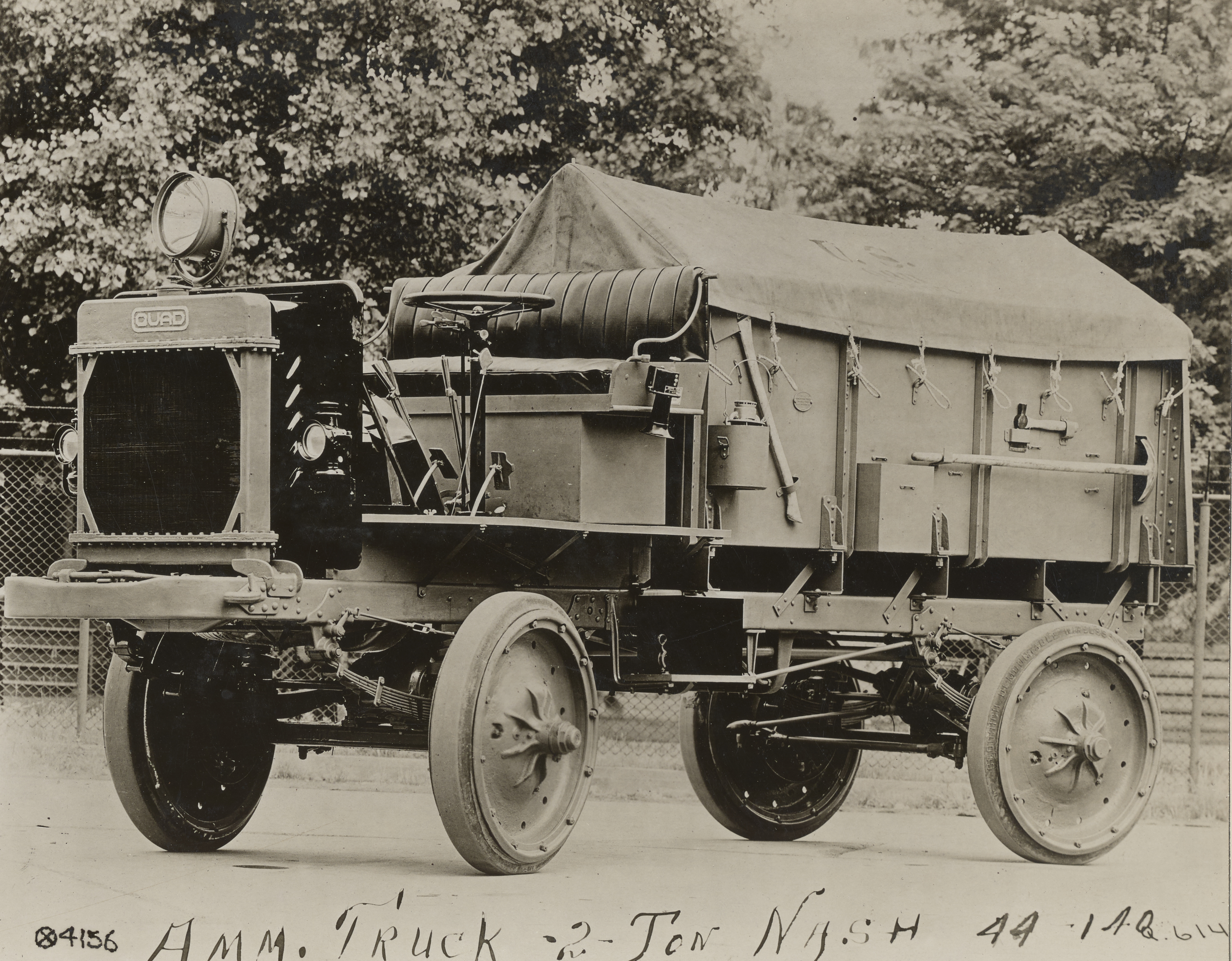
Nash Quad Truck The four-wheel drive Jeffery Quad truck became an important product for Nash. Approximately 11,500 Quads were built between 1913 and 1919. They served to move materiel during World War I under severe conditions. The Quad used Meuhl differentials with half-shafts mounted above the load-bearing dead axles to drive the hubs through hub-reduction gearing.in addition to featuring four-wheel steering. The Quad achieved the reputation of being the best four-wheel drive truck produced in the country. The newly formed Nash Motors became the largest producer of four-wheel drives. By 1918, capacity constraints at Nash meant the Paige-Detroit Motor Car Company began to assemble the Nash Quad under license and Nash patents. Nash became the leading producer of military trucks by the end of World War I. After the war ended, surplus Quads were used as heavy work trucks in fields such as construction and logging. The Jeffery was developed as a result of a visit by the US Army Quartermaster Corps to the Thomas B. Jeffery factory at Kenosha, Wisconsin in 1913. Because of its popularity, the Jeffrey Quad was manufactured in large numbers, including license production by Hudson, National , and Paige-Detroit. |
|---|
Под брендом «Quad» («Jeffery Quad», «Nash Quad») выпускались грузовики с колесной формулой 4x4, отличавшиеся своей проработанной конструкцией, надёжностью и эффективностью.("Its design and durability proved effective in traversing the muddy, rough, and unpaved roads of the times.")
Автомобиль производился компанией, основанной американским изобретателем и предпринимателем Thomas B. Jeffery Company (Kenosha, Wisconsin).
В апреле 1910 года в Помпеях скончался основатель компании Томас Джеффери. В июне того же года его сын, Чарльз, занявший пост руководителя, преобразовал компанию в акционерное общество.
С целью увековечивания памяти отца он сменил марку выпускаемых автомобилей с «Rambler» на «Jeffery».
В 1915 г. жизнь Чарлза резко изменилась - он находился на борту Лузитании, которая подверглась атаке и затонула.
Джеффри выжил, но он потерял интерес к компании.
В августе 1916 года Чарльз Т. Джеффери продал компанию бизнесмену Чарльзу Нэшу.
Нэш (Charles W. Nash) , ушедший до этого с поста президента General Motors переименовал компанию в честь себя.
Под новой вывеской Nash Motors существовала в период с 1917 по 1954 годы, будучи дочерним предприятием Chrysler и American Motors.
К началу Первой мировой войны Неш развернул производство грузовиков под марками «Jeffery Quad» и, после ребрендинга, Quad (Nash-Quad) .
Quad (Nash-Quad) грузовики воевали на фронтах во Франции, служил в России, Великобритании и других союзных государств во время Первой мировой войны.
Автомобили упрямо тянули лямку сквозь грязь и жижу, заменяя лошадей.
11 тыс Nash-Quad были построены в 1918.
Избыточные единицы служили на протяжении десятилетий и после войны.
Конструкция автомобиля была необычной.
В трансмиссии машины были применены три (!!!) дифференциала, причем межосевой имел принудительную блокировку.
Впервые в автомобилестроении использовались штампованные колеса (все остальные фирмы ставили допотопные спицевые).
Карданные валы обоих ведущих мостов имели одинаковую длину, а перед колесными ступицами были установлены шестеренчатые редукторы.
Благодаря такому техническому решению корпусы главных передач получились очень компактными и были смонтированы над балками мостов, в результате самой нижней точкой были балки, а не картеры главных передач, как у машин фирм-конкурентов.
Ремонтопригодность узла была просто превосходная - все на виду.
С 1914 г. в передний и задний мосты Quad стали устанавливать самоблокирующиеся червячные дифференциалы .

4WD dates to the earliest days of truck design with models like the FWD, Jeffrey Quad and the Nash-Quad. Spurred by the First World War—decades before Bantam and Willys competed for a WWII contract—4WD trucks like the Nash-Quad worked at battlefronts, construction sites, road building and mining operations! |
|---|

Nash Motor Company, Kenosha, Wis.Ammunition_truck,_2-t. |
|---|

Differentials with "automatic lockers" and front-rear drive shafts make up the 4WD system. |
|---|

Portal axles. Truck has its differential and driveshafts above the iron beam axle. The iron beam is below the semi-elliptic leaf springs. Ground clearance is ample. Driveshafts are well out of the way.. |
|---|

Drivelines run from the transmission to each axle's differential. |
|---|

The four-speed transmission features power division to each driveline. Here, the rear driveshaft and emergency brake are in view. This basic technology survives to this day in automotive designs. |
|---|

This is advanced chassis and powertrain technology for 1918! |
|---|

The Muehl Differential |
|---|